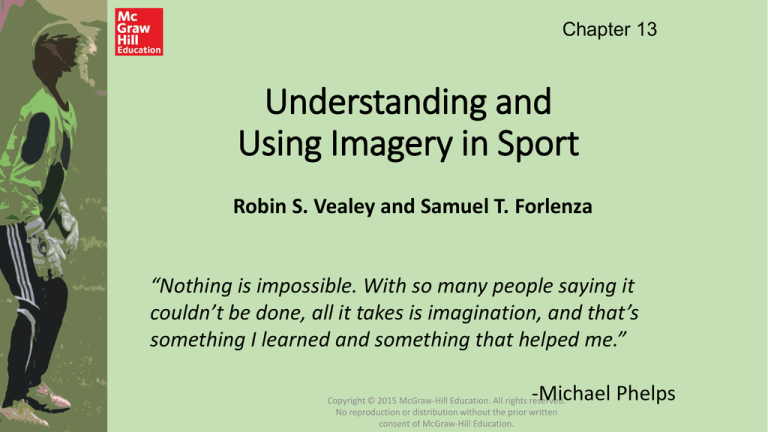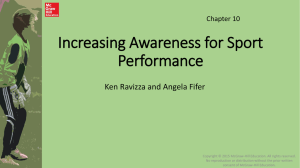
Chapter 13
Understanding and
Using Imagery in Sport
Robin S. Vealey and Samuel T. Forlenza
“Nothing is impossible. With so many people saying it
couldn’t be done, all it takes is imagination, and that’s
something I learned and something that helped me.”
-Michael Phelps
Copyright © 2015 McGraw-Hill Education. All rights reserved.
No reproduction or distribution without the prior written
consent of McGraw-Hill Education.
What Is Imagery?
• Using one’s senses to re-create or
create an experience in the mind
• Allows athletes to practice sport
skills, strategies, and mental skills
without physically being in the
training or competitive
environment
Copyright © 2015 McGraw-Hill Education. All rights reserved. No
reproduction or distribution without the prior written consent of
McGraw-Hill Education.
Re-creating or Creating
• Re-creating
• Uses imagery in a productive and
controlled manner to learn from
performance mistakes
• Helps to program the mind and body to
respond optimally
• Creating
• Build images of new images from pieces
of memory
• Develop effective responses to questions
like “What will it be like?” and “How will
you respond?”
Copyright © 2015 McGraw-Hill Education. All rights reserved. No
reproduction or distribution without the prior written consent of
McGraw-Hill Education.
Imagery as a Polysensory Experience
• Successful imagery should involve all relevant senses:
• Visual
• Auditory
• Olfactory
• Gustatory
• Tactile
• Kinesthetic - the feel or sensation of the body as it
moves in different positions
• Should also work through emotions associated with
various sport experiences
Copyright © 2015 McGraw-Hill Education. All rights reserved. No
reproduction or distribution without the prior written consent of
McGraw-Hill Education.
Imagery as a Mental Training Tool
• Imagery as a mental training tool involves the systematic
practice and use of imagery to engage in vivid and controllable
polysensory images to enhance performance
• Controllability : the ability to imagine exactly what you
intend to imagine PLUS the ability to manipulate aspects of
the images you wish to change
• Vividness: how clear and detailed the image appears
INCLUDING whether the image is in color, how many senses
are being used, and the emotion or physical sensations
experienced when engaging in imagery
Copyright © 2015 McGraw-Hill Education. All rights reserved. No
reproduction or distribution without the prior written consent of
McGraw-Hill Education.
Internal and External Imagery Perspectives
EXTERNAL
INTERNAL
• Seeing the image from
inside their bodies the way
their eyes normally see
• Seeing the image from
outside their bodies as if
they are viewing
themselves
• The only way kinesthetic
imagery can be
experienced
Imagery can be effective using both perspectives
Copyright © 2015 McGraw-Hill Education. All rights reserved. No
reproduction or distribution without the prior written consent of
McGraw-Hill Education.
Copyright © 2015 McGraw-Hill Education. All rights reserved. No reproduction or
distribution without the prior written consent of McGraw-Hill Education.
Mental Practice Research
• Using imagery to perform a specific sport skill
repetitively in the mind
• Occurs across a period of time in an intermittent
learning style
• Complements physical practice
Copyright © 2015 McGraw-Hill Education. All rights reserved. No
reproduction or distribution without the prior written consent of
McGraw-Hill Education.
Preparatory Imagery
• Using imagery immediately before performance can
help athletes perform better
• Can “psych up,” calm down, or focus on relevant aspects of
the task
• Helps with strength tasks, muscular endurance tasks, and
golf putting
• Treat it as part of the preperformance routine
Copyright © 2015 McGraw-Hill Education. All rights reserved. No
reproduction or distribution without the prior written consent of
McGraw-Hill Education.
Multimodal Mental Training Interventions
• Implement with athletes over a period of time
• Works well in combination with other interventions
Copyright © 2015 McGraw-Hill Education. All rights reserved. No
reproduction or distribution without the prior written consent of
McGraw-Hill Education.
Enhancing Competition-Related
Thoughts and Emotions
• A basic objective of sport psychology is to help
athletes manage their thoughts and emotions
effectively to create a productive competitive focus
• Imagery can affects:
•
•
•
•
Self-confidence
Motivation
Attentional control
Athletes’ perceptions of anxiety from harmful and negative
to facilitative and challenging
• Precompetitive anxiety when combined with other mental
training methods
• The self-confidence of coaches
Copyright © 2015 McGraw-Hill Education. All rights reserved. No
reproduction or distribution without the prior written consent of
McGraw-Hill Education.
How Does Imagery Enhance
Athletes’ Performance?
• Bioinformational Explanation
• Functional Equivalence Explanation
• Mental Readiness Explanation
Copyright © 2015 McGraw-Hill Education. All rights reserved. No
reproduction or distribution without the prior written consent of
McGraw-Hill Education.
Can Imagery Hurt Athletes’ Performance?
• Imagery can hurt athletes’ performance if they focus on the
wrong images at the wrong times
• Negative imagery – systematically imagine bad performance
• When individuals were told what not to image, they performed
poorly
• Successful imagery = a mental blueprint for perfect responses, NOT a
mental blueprint for disastrous responses
Copyright © 2015 McGraw-Hill Education. All rights reserved. No
reproduction or distribution without the prior written consent of
McGraw-Hill Education.
Setting Up an Imagery Training Program
1. Introduce imagery to athletes
•
•
•
•
•
•
Hook ’em
Define and give evidence
Explain how it works
String and bolt
Arm as iron bar
Give specifics about how imagery
will be used
Copyright © 2015 McGraw-Hill Education. All rights reserved. No
reproduction or distribution without the prior written consent of
McGraw-Hill Education.
Setting Up an Imagery Training Program
(cont.)
2. Help athletes evaluate their imagery ability
•
•
Sport Imagery Evaluation
Take the athletes through some Basic Training
3. Basic Training
•
•
Similar to a preseason physical conditioning program
Three types of imagery exercises athletes should become
proficient in:
•
•
•
Vividness
Controllability
Self-awareness
Copyright © 2015 McGraw-Hill Education. All rights reserved. No
reproduction or distribution without the prior written consent of
McGraw-Hill Education.
Setting Up an Imagery Training Program
(cont.)
4. Implement a systematic program
• Build the imagery program into the athletes’
routine
• Fit the needs of the athlete
• Follow the KISS principle (keep it simple and
systematic)
• Choose a sport skill or strategy that is easy to
control
Copyright © 2015 McGraw-Hill Education. All rights reserved. No
reproduction or distribution without the prior written consent of
McGraw-Hill Education.
Ways to Use Imagery
• Learning and practicing sport skills
• Mental practice
• Use verbal triggers and symbolic images
• Also helpful for athletes in a slump or having
technique problems
• Correcting mistakes
• Use imagery each time they receive feedback from the
coach
• Can you see it? Can you feel it?
Copyright © 2015 McGraw-Hill Education. All rights reserved. No
reproduction or distribution without the prior written consent of
McGraw-Hill Education.
Ways to Use Imagery (cont.)
• Learning and practicing performance strategies
• Coaches lead athletes in mentally rehearsing before
competition
• Preparing a mental focus for competition
• Coaches should help athletes answer two questions: “What
will it be like?” “How will I respond?”
• Creates a sense of expectancy
Copyright © 2015 McGraw-Hill Education. All rights reserved. No
reproduction or distribution without the prior written consent of
McGraw-Hill Education.
Ways to Use Imagery (cont.)
• Automating preperformance routines
• Preplanned, systematic sequence of thoughts and
behaviors in which an athlete engages prior to performing
a specific skill
• Makes routines more automatic
• Building and enhancing mental skills
•
•
•
•
Self confidence
Energy management
Stress management
Increasing self-awareness
• Aiding in the recovery from injuries
Copyright © 2015 McGraw-Hill Education. All rights reserved. No
reproduction or distribution without the prior written consent of
McGraw-Hill Education.
Times to Use Imagery
• Daily practice
• Pre-performance routine
• Post-performance review
Copyright © 2015 McGraw-Hill Education. All rights reserved. No
reproduction or distribution without the prior written consent of
McGraw-Hill Education.
Strategies to Enhance Imagery Practice
• Athletes should practice imagery in many
different places and positions
• Locker room, on the field, in the pool, during
practice, during competition
• Know when to use real-time, slow motion, and
fast motion imagery
• Help athletes use technology to enhance their
images
Copyright © 2015 McGraw-Hill Education. All rights reserved. No
reproduction or distribution without the prior written consent of
McGraw-Hill Education.
Strategies to Enhance Imagery Practice
(cont.)
• Remember that athletes should imagine vivid mental,
physiological, and behavioral responses to situations
• Image performance and outcome
• Be specific in all uses of imagery
Copyright © 2015 McGraw-Hill Education. All rights reserved. No
reproduction or distribution without the prior written consent of
McGraw-Hill Education.






